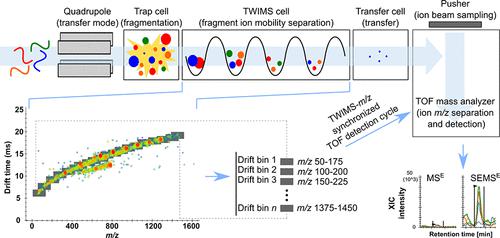当前位置:
X-MOL 学术
›
Anal. Chem.
›
论文详情
Our official English website, www.x-mol.net, welcomes your
feedback! (Note: you will need to create a separate account there.)
Evaluating Peptide Fragment Ion Detection Using Traveling Wave Ion Mobility Spectrometry with Signal-Enhanced MSE (SEMSE)
Analytical Chemistry ( IF 6.7 ) Pub Date : 2022-07-29 , DOI: 10.1021/acs.analchem.2c00461 Juan Camilo Rojas Echeverri 1, 2 , Daniela Volke 1, 2 , Sanja Milkovska-Stamenova 1, 2 , Ralf Hoffmann 1, 2
Analytical Chemistry ( IF 6.7 ) Pub Date : 2022-07-29 , DOI: 10.1021/acs.analchem.2c00461 Juan Camilo Rojas Echeverri 1, 2 , Daniela Volke 1, 2 , Sanja Milkovska-Stamenova 1, 2 , Ralf Hoffmann 1, 2
Affiliation

|
The inherent poor sampling of fragment ions in time-of-flight mass analyzers was recently improved for data-dependent acquisition (DDA) by considering their drift times in traveling wave ion mobility spectrometry (TWIMS). Here, we extend this TWIMS-DDA approach to the data-independent acquisition (DIA) mode MSE to improve the signal intensities of fragment ions by providing improved ion beam sampling efficiency, which we termed therefore signal-enhanced MSE (SEMSE). The theoretical expectation that SEMSE improves the number of identified peptides, the number of quantifiable peptides, and the lower limit of quantitation in wideband DIA was evaluated on an electrospray ionisation-ion mobility spectrometry-quadrupole-time-of-flight-MS (ESI-IMS-Q-TOF-MS) (Synapt G2-Si) in comparison to five established TWIMS-DDA and TWIMS-MSE methods with respect to the number of peptide identifications, the spectral quality of supporting peptide spectra matches, and (most importantly) fragment ion signal sensitivity. A comparison of the fragment signals clearly indicated that SEMSE provides 6.8- to 11.5-fold larger peak areas than established MSE techniques. While this clearly shows the advantages of SEMSE, the inherent limitations of the current software tools do not allow using all benefits in routine analyses. As the simultaneous fragmentation of co-eluting peptides limited peptide identification, DDA and MSE data sets were integrated using Skyline.
中文翻译:

使用带有信号增强 MSE (SEMSE) 的行波离子淌度谱评估肽片段离子检测
最近,通过考虑行波离子迁移谱 (TWIMS) 中碎片离子的漂移时间,改进了飞行时间质量分析仪中碎片离子固有的采样不佳的数据依赖采集 (DDA)。在这里,我们将这种 TWIMS-DDA 方法扩展到数据独立采集 (DIA) 模式 MS E,以通过提高离子束采样效率来提高碎片离子的信号强度,因此我们将其称为信号增强 MS E (SEMS E ) . SEMS E的理论期望在电喷雾电离-离子迁移谱-四极杆-飞行时间-MS (ESI-IMS-Q-TOF -MS) (Synapt G2-S i ) 与五种已建立的 TWIMS-DDA 和 TWIMS-MS E方法在肽鉴定数量、支持肽光谱匹配的光谱质量和(最重要的)碎片离子信号方面的比较灵敏度。碎片信号的比较清楚地表明,SEMS E提供的峰面积比现有的 MS E技术大 6.8 到 11.5 倍。虽然这清楚地显示了 SEMS E的优势,当前软件工具的固有局限性不允许在常规分析中使用所有优点。由于共洗脱肽的同时片段化限制了肽鉴定,因此使用 Skyline 整合了 DDA 和 MS E数据集。
更新日期:2022-07-29
中文翻译:

使用带有信号增强 MSE (SEMSE) 的行波离子淌度谱评估肽片段离子检测
最近,通过考虑行波离子迁移谱 (TWIMS) 中碎片离子的漂移时间,改进了飞行时间质量分析仪中碎片离子固有的采样不佳的数据依赖采集 (DDA)。在这里,我们将这种 TWIMS-DDA 方法扩展到数据独立采集 (DIA) 模式 MS E,以通过提高离子束采样效率来提高碎片离子的信号强度,因此我们将其称为信号增强 MS E (SEMS E ) . SEMS E的理论期望在电喷雾电离-离子迁移谱-四极杆-飞行时间-MS (ESI-IMS-Q-TOF -MS) (Synapt G2-S i ) 与五种已建立的 TWIMS-DDA 和 TWIMS-MS E方法在肽鉴定数量、支持肽光谱匹配的光谱质量和(最重要的)碎片离子信号方面的比较灵敏度。碎片信号的比较清楚地表明,SEMS E提供的峰面积比现有的 MS E技术大 6.8 到 11.5 倍。虽然这清楚地显示了 SEMS E的优势,当前软件工具的固有局限性不允许在常规分析中使用所有优点。由于共洗脱肽的同时片段化限制了肽鉴定,因此使用 Skyline 整合了 DDA 和 MS E数据集。











































 京公网安备 11010802027423号
京公网安备 11010802027423号